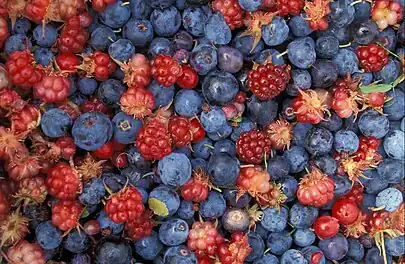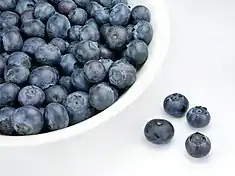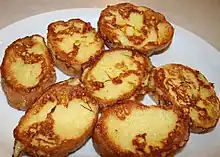F o o d
A portal dedicated to food and foodways
Introduction
.jpg.webp)
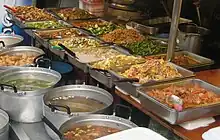
Food is any substance consumed by an organism for nutritional support. Food is usually of plant, animal, or fungal origin and contains essential nutrients such as carbohydrates, fats, proteins, vitamins, or minerals. The substance is ingested by an organism and assimilated by the organism's cells to provide energy, maintain life, or stimulate growth. Different species of animals have different feeding behaviours that satisfy the needs of their metabolisms and have evolved to fill a specific ecological niche within specific geographical contexts.
Omnivorous humans are highly adaptable and have adapted to obtain food in many different ecosystems. Humans generally use cooking to prepare food for consumption. The majority of the food energy required is supplied by the industrial food industry, which produces food through intensive agriculture and distributes it through complex food processing and food distribution systems. This system of conventional agriculture relies heavily on fossil fuels, which means that the food and agricultural systems are one of the major contributors to climate change, accounting for as much as 37% of total greenhouse gas emissions. (Full article...)
Cooking, also known as cookery or professionally as the culinary arts, is the art, science and craft of using heat to make food more palatable, digestible, nutritious, or safe. Cooking techniques and ingredients vary widely, from grilling food over an open fire to using electric stoves, to baking in various types of ovens, reflecting local conditions.
Preparing food with heat or fire is an activity unique to humans. Archeological evidence of cooking fires from at least 300,000 years ago exists, but some estimate that humans started cooking up to 2 million years ago.
The expansion of agriculture, commerce, trade, and transportation between civilizations in different regions offered cooks many new ingredients. New inventions and technologies, such as the invention of pottery for holding and boiling of water, expanded cooking techniques. Some modern cooks apply advanced scientific techniques to food preparation to further enhance the flavor of the dish served. (Full article...)
 Good article –
Good article –

Mediterranean cuisine is the food and methods of preparation used by the people of the Mediterranean Basin. The idea of a Mediterranean cuisine originates with the cookery writer Elizabeth David's book, A Book of Mediterranean Food (1950) and was amplified by other writers working in English.
Many writers define the three core elements of the cuisine as the olive, wheat, and the grape, yielding olive oil, bread and pasta, and wine; other writers deny that the widely varied foods of the Mediterranean basin constitute a cuisine at all. A common definition of the geographical area covered, proposed by David, follows the distribution of the olive tree. (Full article...)
Selected article –

The 2008 Chinese milk scandal was a significant food safety incident in China. The scandal involved Sanlu Group's milk and infant formula along with other food materials and components being adulterated with the chemical melamine, which resulted in kidney stones and other kidney damage in infants. The chemical was used to increase the nitrogen content of diluted milk, giving it the appearance of higher protein content in order to pass quality control testing. 300,000 affected children were identified, among which 54,000 were hospitalized, according to the latest report in January 2009. The deaths of six babies were officially concluded to be related to the contaminated milk.
The timeline of the scandal dated back to December 2007, when Sanlu began to receive complaints about kidney stones. One of the more notable early complaints was made on 20 May 2008, when a mother posted online after she learnt that Sanlu donated the milk she had been complaining about to the orphans of the 2008 Sichuan earthquake. Also on 20 May, the problem reached Sanlu's Board meeting the first time and they ordered multiple third-party tests. The culprit, melamine, was undetected in the tests until 1 August. On 2 August, Sanlu's Board decided to issue a trade recall to the wholesalers but did not inform the wholesalers the product was contaminated; however, Shijiazhuang's deputy mayor, who was invited to attend, rejected trade recall and instructed the Board to "shut the mouths of the victims by money", "wait until the end of 2008 Beijing Olympics to end smoothly and then the provincial police would hunt the perpetrators". New Zealand dairy giant Fonterra, which owned a 43% stake in Sanlu, were alerted to the contamination on 2 August's Board meeting. Fonterra alerted the New Zealand government and the NZ government confronted the Chinese government on 8 September. The Chinese government made the scandal public on 13 September. After the initial focus on Sanlu, further government inspections revealed that products from 21 other companies were also tainted, including those from Arla Foods–Mengniu, Yili, and Yashili. While more and more cases reached hospitals around the nation from December 2007, the first report to the government by any hospital was made on 16 July. (Full article...)Selected cuisine -

Iranian cuisine is the culinary traditions of Iran. Due to the historically common usage of the term "Persia" to refer to Iran in the Western world, it is alternatively known as Persian cuisine, despite Persians being only one of a multitude of Iranian ethnic groups who have contributed to Iran's culinary traditions.
Iran has a variety of 2,500 types of traditional food, one of the richest in the world. The cuisine of Iran has made extensive contact throughout its history with the cuisines of its neighbouring regions, including Caucasian cuisine, Central Asian cuisine, Greek cuisine, Levantine cuisine, Mesopotamian cuisine, Russian cuisine and Turkish cuisine. Aspects of Iranian cuisine have also been significantly adopted by Indian cuisine and Pakistani cuisine through various historical Persianate sultanates that flourished during Muslim rule on the Indian subcontinent, with the most notable and impactful of these polities being the Mughal Empire. (Full article...)Selected ingredient –
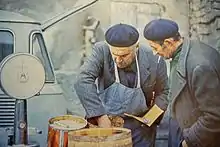
Anchovies are small, common saltwater forage fish in the family Engraulidae that are used as human food and fish bait. There are 144 species in 17 genera found in the Atlantic, Indian, and Pacific Oceans. Anchovies are usually classified as oily fish. They are small, green fish with blue reflections due to a silver longitudinal stripe that runs from the base of the caudal fin. They range from 2 centimetres (0.79 in) to 40 centimetres (16 in) in adult length, and the body shape is variable, with more slender fish in northern populations.
A traditional method of processing and preserving anchovies is to gut and salt them in brine, allow them to cure, and then pack them in oil or salt. This results in the characteristic strong flavor associated with anchovies, and their flesh turns deep grey. Anchovies pickled in vinegar, as with Spanish boquerones en vinagre, are milder, and the flesh retains a white color. For domestic use, anchovy fillets are sometimes packed in oil or salt in small tins or jars, sometimes rolled around capers. Anchovy paste is also available, as is anchovy essence. Anchovy mash is also sold in the UK under the label of Gentleman's Relish. (Full article...)
Selected recipe –
French toast is a dish of sliced bread soaked in beaten eggs and often milk or cream, then pan-fried. Alternative names and variants include eggy bread, Bombay toast, gypsy toast, and poor knights (of Windsor).
When French toast is served as a sweet dish, sugar, vanilla, or cinnamon are also commonly added before pan-frying, and then it may be topped with sugar (often powdered sugar), butter, fruit, or syrup. When it is a savory dish, it is generally fried with a pinch of salt or pepper, and it can then be served with a sauce such as ketchup or mayonnaise. (Full article...)
 Featured article –
Featured article –
New Paltz station is a former train station in the village of New Paltz in Ulster County, New York. The building was the first of two railroad stations constructed in the town of New Paltz, and it is the only former Wallkill Valley Railroad station standing at its original location.
After a lengthy public debate over whether to place the station to the east or west of the Wallkill River, it was built in 1870 on the east bank, within the village of New Paltz. The rail line was formally opened during a large ceremony on December 20, 1870. A decade later the station had become a popular departure point for the Mohonk Mountain House by many vacationers, including two U.S. presidents. In the late 19th century, over a dozen stagecoaches ran between the station and Mohonk daily. (Full article...)Selected image –
Selected biography –

B. July 30, 1962
Alton Crawford Brown Jr. (born July 30, 1962) is an American television personality, food show presenter, food scientist, author, voice actor, and cinematographer. He is the creator and host of the Food Network television show Good Eats that ran for 16 seasons, host of the miniseries Feasting on Asphalt and Feasting on Waves, and host and main commentator on Iron Chef America and Cutthroat Kitchen. Brown is a best-selling author of several books on food and cooking. A recap series titled Good Eats Reloaded aired on Cooking Channel, and a true sequel series, Good Eats: The Return, ran from 2019 to 2021 on Food Network. (Full article...)
Did you know (auto-generated) –
- ... that Cranksgiving has been described as "part bike ride, part food drive, part scavenger hunt"?
- ... that a New York pop-up restaurant opened by Louisa Shafia served stews and rice dishes described in a review as a "Persian-tapas gateway into the ancient cuisine"?
- ... that Cibo paints Italian food over neo-fascist graffiti?
- ... that sand in the stomach of the ocean surgeon helps to grind up its food?
- ... that staff at the vegan food brand VFC interact with internet trolls on social media platforms to grow their online brand?
- ... that fermented leaves are used to make a meat substitute in Sudan called kawal?
More did you know –
Related portals
Food topics
The following are topics relating to food
Categories
The following are categories relating to food.
![]()
Food list articles
- See also: Lists of foods and Category:Lists of drinks
The following are some Food list articles on Wikipedia:
- American cheeses
- Appellation d'Origine Contrôlée cheeses
- Apple cultivars
- Bacon dishes
- Bacon substitutes
- Basil cultivars
- Breads
- Breakfast beverages
- Breakfast cereals
- Breakfast foods
- British cheeses
- Cakes
- Candies
- Cheeses
- Cheese soups
- Christmas dishes (list)
- Cocktails
- Cookies
- Dishes using coconut milk
- Diets
- Doughnut varieties
- Egg dishes
- Fermented soy products
- Food additives
- Food additives (Codex Alimentarius)
- Foods named after people
- French cheeses
- French dishes
- Fried dough foods
- Fruits
- List of hamburgers
- Herbs and spices
- Hors d'oeuvre
- Indian dishes
- Indian snack foods
- Indonesian dishes
- Italian dishes
- Japanese snacks
- Japanese dishes
- Jewish dishes
- Kebabs
- Korean beverages
- Mango cultivars
- Moroccan dishes
- Pasta
- Pastries
- Philippine snack food
- Pies, tarts and flans
- Poppy seed pastries and dishes
- Potato dishes
- Puddings
- Raw fish dishes
- Rice dishes
- Rolled foods
- Sauces
- Seafood
- Seeds
- Sandwiches
- Snack foods
- Soft drinks by country
- Soul foods and dishes
- Soups
- Stews
- Street foods
- Tapas
- Turkish dishes
- Twice-baked foods
- Vegetable oils
- Vegetables
- Vodkas
Things you can do
 |
Here are some tasks awaiting attention:
|
Related WikiProjects
| Parent project: WikiProject Food and Drink | view |
| Child projects: | Task forces: (All inactive) |
|
|
| Related projects: | |
|
New articles
Rules | Match log | Results page (for watching) | Last updated: 2024-01-13 19:29 (UTC)
Note: The list display can now be customized by each user. See List display personalization for details.
- John Hammond, Intolerant Champion (edit | talk | history | links | watch | logs | tools) by Whispyhistory (talk · contribs · new pages (4)) started on 2024-01-13, score: 10
- Alan Smith (speedway rider) (edit | talk | history | links | watch | logs | tools) by Pyeongchang (talk · contribs · new pages (58)) started on 2024-01-12, score: 10
- Beatbox Kitchen (edit | talk | history | links | watch | logs | tools) by Jack4576 (talk · contribs · new pages (2)) started on 2024-01-12, score: 10
- Miranda Mirosa (edit | talk | history | links | watch | logs | tools) by DrThneed (talk · contribs · new pages (22)) started on 2024-01-11, score: 10
- Wet hamburger (edit | talk | history | links | watch | logs | tools) by Uthoperis (talk · contribs · new pages (2)) started on 2024-01-09, score: 30
- Tabaheg (edit | talk | history | links | watch | logs | tools) by Balash-Vologases (talk · contribs · new pages (4)) started on 2024-01-11, score: 20
- Coconut shell cup (edit | talk | history | links | watch | logs | tools) by Wbm1058 (talk · contribs · new pages (13)) started on 2024-01-11, score: 10
- Juliet Harbutt (edit | talk | history | links | watch | logs | tools) by BJCHK (talk · contribs · new pages (3)) started on 2024-01-10, score: 20
- Murder and Cocktails (edit | talk | history | links | watch | logs | tools) by Filmforme (talk · contribs · new pages (23)) started on 2024-01-09, score: 10
- Heidi Chocolat AG, Niemetz Schwedenbomben (edit | talk | history | links | watch | logs | tools) by Mister Bucket (talk · contribs · new pages (2)) started on 2024-01-09, score: 20
- Fruit Bursts (edit | talk | history | links | watch | logs | tools) by Panamitsu (talk · contribs · new pages (185)) started on 2024-01-08, score: 20
- FMUATW (edit | talk | history | links | watch | logs | tools) by BiggestBidder (talk · contribs · new pages (2)) started on 2024-01-08, score: 10
- Diet for a New America (film) (edit | talk | history | links | watch | logs | tools) by Classicfilms (talk · contribs · new pages (4)) started on 2024-01-08, score: 20
- Korean Cuisine and Dining (edit | talk | history | links | watch | logs | tools) by Toobigtokale (talk · contribs · new pages (33)) started on 2024-01-07, score: 10
- Morisqueta tostada (edit | talk | history | links | watch | logs | tools) by Obsidian Soul (talk · contribs · new pages (11)) started on 2024-01-07, score: 20
- Guy Snyder (businessman) (edit | talk | history | links | watch | logs | tools) by Gordonhigh (talk · contribs · new pages (1)) started on 2024-01-07, score: 10
- Sir Michael Colman, 3rd Baronet (edit | talk | history | links | watch | logs | tools) by Richiepip (talk · contribs · new pages (14)) started on 2024-01-06, score: 10
- Wal Morton (edit | talk | history | links | watch | logs | tools) by Pyeongchang (talk · contribs · new pages (58)) started on 2024-01-06, score: 10
- Cigarette cookies (edit | talk | history | links | watch | logs | tools) by Skibidi Toilet Gyat Sigma (talk · contribs · new pages (0)) started on 2024-01-04, score: 10
- Birra Peja (edit | talk | history | links | watch | logs | tools) by Digiperson (talk · contribs · new pages (2)) started on 2023-12-30, score: 10
- Third-party cookies (edit | talk | history | links | watch | logs | tools) by The Anome (talk · contribs · new pages (9)) started on 2024-01-05, score: 10
- Karlsbad-style coffee maker (edit | talk | history | links | watch | logs | tools) by Matthiaspaul (talk · contribs · new pages (228)) started on 2024-01-04, score: 10
- Arthur Barmby (edit | talk | history | links | watch | logs | tools) by StickeyWicket (talk · contribs · new pages (28)) started on 2024-01-04, score: 10
- Midor (edit | talk | history | links | watch | logs | tools) by Mister Bucket (talk · contribs · new pages (2)) started on 2024-01-04, score: 20
- Loungers (edit | talk | history | links | watch | logs | tools) by Mechanical Elephant (talk · contribs · new pages (9)) started on 2024-01-04, score: 20
- Margaret Costa (food writer) (edit | talk | history | links | watch | logs | tools) by EEHalli (talk · contribs · new pages (2)) started on 2024-01-03, score: 10
- Shower beer (edit | talk | history | links | watch | logs | tools) by Milowent (talk · contribs · new pages (7)) started on 2024-01-03, score: 10
- Jimmie Gibb (edit | talk | history | links | watch | logs | tools) by Pyeongchang (talk · contribs · new pages (58)) started on 2024-01-03, score: 10
- Clem Mitchell (edit | talk | history | links | watch | logs | tools) by Pyeongchang (talk · contribs · new pages (58)) started on 2024-01-03, score: 10
- R. E. O'Callaghan (edit | talk | history | links | watch | logs | tools) by Throughthemind (talk · contribs · new pages (4)) started on 2024-01-03, score: 10
- Juicy Fruit (Brooke Candy song) (edit | talk | history | links | watch | logs | tools) by BiggestBidder (talk · contribs · new pages (2)) started on 2024-01-03, score: 10
- Steven A. Shaw (edit | talk | history | links | watch | logs | tools) by Thriley (talk · contribs · new pages (122)) started on 2024-01-03, score: 10
- Charlie Spinks (edit | talk | history | links | watch | logs | tools) by Pyeongchang (talk · contribs · new pages (58)) started on 2024-01-02, score: 10
- Ketchup potato chip (edit | talk | history | links | watch | logs | tools) by Clovermoss (talk · contribs · new pages (9)) started on 2024-01-02, score: 20
- Lil Red Takeout and Catering (edit | talk | history | links | watch | logs | tools) by Another Believer (talk · contribs · new pages (63)) started on 2024-01-02, score: 10
- Cantharellus alborufescens (edit | talk | history | links | watch | logs | tools) by Cs california (talk · contribs · new pages (90)) started on 2024-01-01, score: 10
- Cantharellus ferruginascens (edit | talk | history | links | watch | logs | tools) by Cs california (talk · contribs · new pages (90)) started on 2024-01-01, score: 10
- Cantharellus iuventateviridis (edit | talk | history | links | watch | logs | tools) by Cs california (talk · contribs · new pages (90)) started on 2024-01-01, score: 10
- Cantharellus velutinus (edit | talk | history | links | watch | logs | tools) by Cs california (talk · contribs · new pages (90)) started on 2024-01-01, score: 10
- Cantharellus parvoflavus (edit | talk | history | links | watch | logs | tools) by Cs california (talk · contribs · new pages (90)) started on 2024-01-01, score: 10
- Cantharellus confluens (edit | talk | history | links | watch | logs | tools) by Cs california (talk · contribs · new pages (90)) started on 2024-01-01, score: 10
- Local Tide (edit | talk | history | links | watch | logs | tools) by Another Believer (talk · contribs · new pages (63)) started on 2024-01-01, score: 10
- Arthur Warwick (edit | talk | history | links | watch | logs | tools) by Pyeongchang (talk · contribs · new pages (58)) started on 2024-01-01, score: 10
- Bretel butter (edit | talk | history | links | watch | logs | tools) by Ruthgrace (talk · contribs · new pages (2)) started on 2023-12-30, score: 20
- Tiger Hart (edit | talk | history | links | watch | logs | tools) by Pyeongchang (talk · contribs · new pages (58)) started on 2024-01-01, score: 10
- Toni Okamoto (edit | talk | history | links | watch | logs | tools) by Classicfilms (talk · contribs · new pages (4)) started on 2023-12-31, score: 10
- Reg Trott (edit | talk | history | links | watch | logs | tools) by Pyeongchang (talk · contribs · new pages (58)) started on 2023-12-31, score: 10
- Le Rat Mort (edit | talk | history | links | watch | logs | tools) by ABF992 (talk · contribs · new pages (2)) started on 2023-12-31, score: 20
- Litti Chokha (dish) (edit | talk | history | links | watch | logs | tools) by Hiraditya (talk · contribs · new pages (3)) started on 2023-12-30, score: 10
- Litti Chokha (Dish) (edit | talk | history | links | watch | logs | tools) by Hiraditya (talk · contribs · new pages (3)) started on 2023-12-30, score: 10
Associated Wikimedia
The following Wikimedia Foundation sister projects provide more on this subject:
-
 Commons
Commons
Free media repository -
 Wikibooks
Wikibooks
Free textbooks and manuals -
 Wikidata
Wikidata
Free knowledge base -
 Wikinews
Wikinews
Free-content news -
 Wikiquote
Wikiquote
Collection of quotations -
 Wikisource
Wikisource
Free-content library -
 Wikiversity
Wikiversity
Free learning tools -
 Wiktionary
Wiktionary
Dictionary and thesaurus
Sources
More portals
-
 List of all portals
List of all portals -

-

-

-

-

-

-

-

-

-
 Random portal
Random portal -
 WikiProject Portals
WikiProject Portals
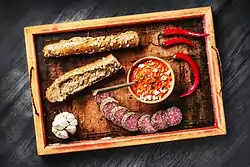





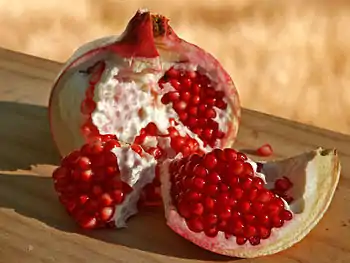

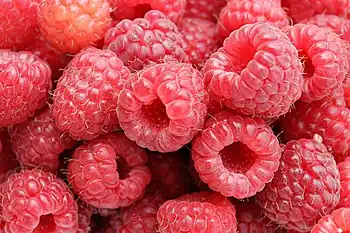
.jpg.webp)





